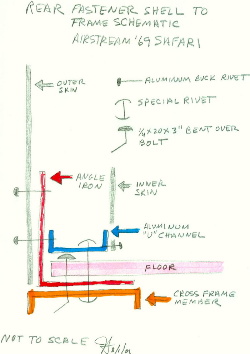VAC E-mail List Archive
The Vintage Airstream E-mail List
Archive Files
[Date Prev][Date Next][Thread Prev][Thread Next][Date Index][Thread Index]
[VAC] Re: what brand of tire is good?
Hi All,
I don't get it about "front plate" protection and front plate separation
that can be the result of using radial tires vs.. bias ply.
The only thing that I can imagine that could cause the front plate to
separate from the frame is flexing of the "A" frame with the pivot point
located well behind the front plate. This assumes that the plate is the
angle iron that extends about 9 inches up behind the outer skin and has a
double row of rivets to bond it to the skin. The foot of the angle iron
extends about an inch under the floor, inside the aluminum "U" channel that
secures the upper structure to the floor/frame with rivets and bolts. (see
small attached sketch)
I can imagine that the reason for the separation does not have anything to
do with tires or the equalizer hitch assembly. I've noted severe corrosion
(rust) of the washers that secure the rivet heads (both top and bottom) that
bind the upper body to the frame. I recall that there are 5 rivets.
Additionally, there are about five 1/4 X 20 X 3 inch bolts that secure the
floor to the frame in the same vicinity. The ten bolts/rivets pass through
the foot of the angle iron that may be the referenced "front plate". If
this the point of separation, the flex may contribute, but the root of the
problem is failure of the fasteners from corrosion.
I've noticed a similar problem with pop-type rivets where the pull stem is
steel in an aluminum rivet. The corrosion eventually causes the rivet to
fail (these hold the trim strip and banana curve and most of the belly pan).
I have NOT noticed any deterioration of the "buck-type" rivets that are used
through out the A/S to fasten aluminum to aluminum. However, the vertical
section of the angle IRON is riveted to the aluminum skin with aluminum
rivets. It's possible that electrolysis could compromise the double row of
rivets.
It seems that the specific point of separation must be identified. Either
the vertical plate or the foot under the floor. It's logical that once the
fasteners are weakened in either location, the soft aluminum would
eventually fail. Same seems true for the rivets that bind the aluminum "U"
channel to the floor/frame. If the rivets through the foot of the angle
iron are compromised by corrosion, it is most assured that the floor is
rotted and soft. This would allow the foot to move and eventually cause
failure of the rivets.
All this said, it's strictly my opinion that tires and flexing of the "A"
frame may contribute to separation of the "plate" (assuming I've properly
identified what the plate is); however, the cause is corrosion from water
where it shouldn't be. To me, this makes caulking of the banana curve seam
under the trim strip and other seams around the "A" frame cutouts a critical
owner maintenance task. Much like maintenance caulking roof openings.
I noted the severe corrosion of these fasteners in both the front and rear
of my '69 Safari when I opened the inner skin to replace sections of
flooring. Associated with this corrosion was near total disintegration of
the floor pinched between the frame/angle iron/aluminum "U" channel.
It seems that once the rivets/fasteners are compromised, protecting the
"plate" by taking it easy only delays a future catastrophe. My choice is to
be sure the fasteners are not subjected to the elements that cause corrosion
and floor rot. I would advise A/S restorers to pay particular attention to
these fasteners.
The small sketch is attached to show the rear connection; however, it is
nearly identical to the front connection and might help visualize what I
tried to describe.
Joy


